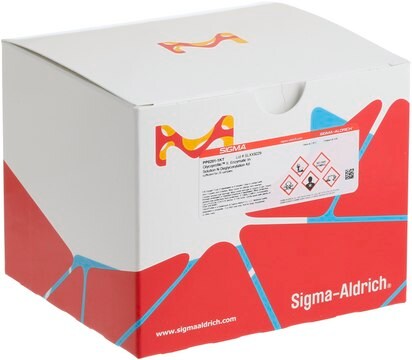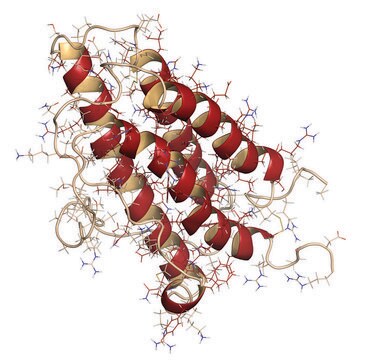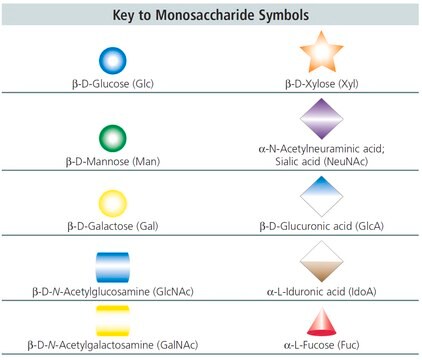G5166
PNGase F from Elizabethkingia miricola
buffered aqueous solution
Synonym(s):
N-Glycosidase F, Peptide N-glycosidase
Sign Into View Organizational & Contract Pricing
All Photos(1)
About This Item
CAS Number:
MDL number:
UNSPSC Code:
12352204
NACRES:
NA.32
Recommended Products
biological source
bacterial (Elizabethkingia miricola)
Quality Level
conjugate
(N-linked)
form
buffered aqueous solution
specific activity
≥20000 units/mg protein
mol wt
36 kDa
shipped in
wet ice
storage temp.
2-8°C
General description
PNGase F (Peptide N-glycosidase F) cleaves asparagine-linked glycoproteins, which produces carbohydrate-free peptides and detached full-length oligosaccharides.
Application
PNGase F from Elizabethkingia miricola has been used for the deglycosylation of the proteins.
Used to deglycosylate protein.
Biochem/physiol Actions
Cleaves an entire glycan from a glycoprotein provided the glycosylated asparagine moiety is substituted on its amino and carboxyl terminus with a polypeptide chain.
Unit Definition
One unit will catalyze the release of N-linked oligosaccharides from 1 nanomole of denatured ribonuclease B in one minute at 37°C at pH 7.5 monitored by SDS-PAGE. One Sigma unit of PNGase F activity is equal to 1 IUB milliunit.
Physical form
Supplied as a solution in 20 mM Tris HCl, pH 7.5, 50 mM NaCl and 1 mM EDTA
Signal Word
Danger
Hazard Statements
Precautionary Statements
Hazard Classifications
Resp. Sens. 1
Storage Class Code
12 - Non Combustible Liquids
WGK
WGK 2
Flash Point(F)
Not applicable
Flash Point(C)
Not applicable
Personal Protective Equipment
dust mask type N95 (US), Eyeshields, Gloves
Certificates of Analysis (COA)
Search for Certificates of Analysis (COA) by entering the products Lot/Batch Number. Lot and Batch Numbers can be found on a product’s label following the words ‘Lot’ or ‘Batch’.
Already Own This Product?
Find documentation for the products that you have recently purchased in the Document Library.
Customers Also Viewed
A novel humanized GLP-1 receptor model enables both affinity purification and Cre-LoxP deletion of the receptor
Jun LS, et al.
PLoS ONE, 9(4), e93746-e93746 (2014)
Ying-Nai Wang et al.
STAR protocols, 3(1), 101198-101198 (2022-03-05)
Immunotherapy via PD-1/PD-L1 blockade is a promising strategy to eradicate cancer cells. However, the PD-L1 pathological level is inconsistent with the therapeutic response and is not a reliable biomarker to stratify patients for anti-PD-1/PD-L1 therapy. Here, we describe patient sample deglycosylation
Identification and Characterization of a Novel Prokaryotic Peptide N-GLYCOSIDASE FROM ELIZABETHKINGIA MENINGOSEPTICA
Sun G, et al.
The Journal of Biological Chemistry, 290(12), 7452-7462 (2015)
Lucy S Jun et al.
PloS one, 9(4), e93746-e93746 (2014-04-04)
Class B G protein-coupled receptors (GPCRs) are important regulators of endocrine physiology, and peptide-based therapeutics targeting some of these receptors have proven effective at treating disorders such as hypercalcemia, osteoporosis, and type 2 diabetes mellitus (T2DM). As next generation efforts
Gyoung Nyoun Kim et al.
PLoS pathogens, 17(12), e1010092-e1010092 (2021-12-17)
The development of safe and effective vaccines to prevent SARS-CoV-2 infections remains an urgent priority worldwide. We have used a recombinant vesicular stomatitis virus (rVSV)-based prime-boost immunization strategy to develop an effective COVID-19 vaccine candidate. We have constructed VSV genomes
Articles
N-Linked Glycan Strategies.
Our team of scientists has experience in all areas of research including Life Science, Material Science, Chemical Synthesis, Chromatography, Analytical and many others.
Contact Technical Service












